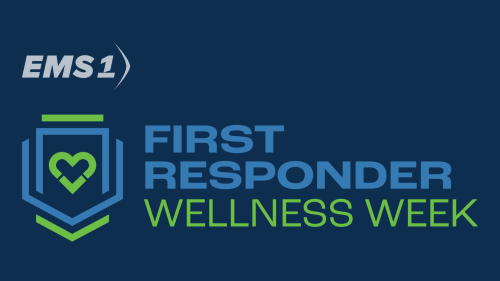In the hustle and bustle of modern life, amidst the demands of our EMS work, family and home responsibilities, it’s easy to let our health take a backseat. But what if I told you that change is not only possible, but within your grasp?
Let me tell you about an incredible journey of transformation that can serve as a beacon of hope and inspiration for us all. Imagine being able to lose 100 pounds in under 2 years, come off diabetes medication and CPAP, and reduce your blood pressure medications. Well, it happened for me, and I also had tremendous changes in my labs and vital signs, most importantly reducing my A1C from 11.2% to 4.8%.
This story is one of resilience, determination and unwavering commitment to change. Facing the harsh realities of newly diagnosed type 2 diabetes and increasing hypertension, I knew something had to give. But change, as I discovered, isn’t just about flipping a switch – it’s a multifaceted journey that requires dedication, support, perseverance and a clear vision. Most importantly, to be properly motivated to change, one must have a passionate reason; the why.
The power of why
The power of the why is that it belongs solely to you. At the heart of my transformation was a powerful “why” – a compelling reason that fueled my desire for change – being there for my family. I had a granddaughter and possibly more grandchildren to come who I needed to be able to get down, jump up and run around with. My PA also made sure to remind me of the negative potential outcomes of diabetes: dialysis, wound care and amputation.
Whether it’s reclaiming your health, setting an example for loved ones or simply wanting to live life to the fullest, having a clear purpose that you are passionate about is essential in navigating the ups and downs of the journey ahead.
Setting a clear vison, goals and objectives takes some time and thought, but to do change right, you don’t want to rush into it. I used the SMART goal design (Specific, Measurable, Achievable, Realistic and Timely). My physician and nutritionist helped set my vision, although they did think a 70-pound loss in a year was a stretch. There were other steps and metrics included, from body fat percentage to BP. I remembered the W.E. Deming quote: “What gets measured gets done.”
The vital signs (e.g., weight, glucose, BP, inches and body fat percentage) served as tangible progress metrics. Of course, there are several apps and tools available today to track these metrics, from scales to smart watches, glucometers and more. I even wrote these goals on my mirror so I would see them daily. By setting clear, achievable goals and outlining actionable steps to reach them, I was able to stay focused and motivated, even when faced with challenges.
A plan and pathway to success
Central to my success was a well-defined plan and pathway to achieve these goals. By breaking down some of the objectives into manageable steps and continuously evaluating and improving my approach, I was able to stay on track and make steady progress. This took a lot of collaboration and communication with my physician and nutritionist, along with other caregivers, and supportive family and friends.
I set my start time each morning for 0313. My wife and son had both played sports under the numbers 13 and 3. So by setting my wake-up time to 0313, it reminded me every morning why I was getting up so early.
Each day, I recorded my measurements and vital signs. I would then complete a 45-minute walk outdoors, with my wife accompanying me sometimes, before completing my daily devotional reading and meditation. Then I would eat my breakfast and pack my lunch, plus snacks, along with my gallon jug of water to drink at work. When I came home, it was another 45-minute walk or exercise before supper (sometimes after if it was a long day). Sundays became food prep day and planning the weekly menu with my wife.
This was all part of the plan and as the journey continued, I re-evaluated my progress through my measurements and metrics, then adapted the plan based on the outcomes I had achieved (or not). There were times when I plateaued or even gained weight back. That’s when I went back and studied to reaffirm and re-educate myself.
Education, training and adaptability
I had to arm myself with knowledge and stay open to new ideas and approaches to achieve change. Digging into the details is important, from the macros of nutrition to the mechanics of exercise. I studied best practices from a variety of people, including athletes, extreme sports competitors, combat performers, as well as vegan diets. Practicing putting these things into action properly was instrumental in the transformation. I am lucky enough to have a wife who was a coach, so I did not need a trainer to help with the exercise pieces. Through education, training and a willingness to adapt, I gained the tools and insights needed to navigate this healthy journey effectively.
Support systems
Support systems and accountability mechanisms are a must have, to be successful in any plan for change. Identify the stakeholders who are part of your why and those who will benefit from your journey of change. I enlisted my family, work family, friends and neighbors. Not only did I share my why with them, I also explained some of the process so they would understand what I was doing. This also helped them to know what I should not be doing, and I gave permission to this team to hold me accountable. Remember that accountability can be both positive and negative reinforcement. I took the extra step to post my goals and progress in public – in my case, on social media. While many encouraged and congratulated me, I am also a realist and knew some would watch for my missteps to point them out (even if only to others in private) – another source of motivation.
I cannot emphasize enough the crucial role of support systems in facilitating change. Whether it’s team members, caregivers, family members or friends, having a strong network of individuals who believe in your journey can make all the difference.
Learn more about the impact of peer support:
Appreciate and reward changes and success
Write down your goals and objectives, then when you hit them, take the time to celebrate. Even a small win deserves recognition and celebration. Make sure these celebrations involve all who are a part of your support system. Even changes in that direction or breaking through a plateau can be celebrated. This journey underscored the importance of acknowledging and celebrating every milestone along the way. From shedding 100 pounds in under 2 years, to getting off CPAP, to witnessing a remarkable improvement in my A1c, triglycerides and cholesterol levels, each victory propelled me forward. Whether it’s reaching a fitness milestone, sticking to a healthy eating plan or simply making it through a challenging day, acknowledging progress is key to staying motivated and focused.
There is no easy button here. Every path to successful change requires some perseverance and dedication. Above all, change is an ongoing journey towards improvement. Despite setbacks and obstacles, by remaining steadfast in a commitment to change and leaning on your support system, change is achievable. It just takes one step at a time, one day at a time, to keep moving forward.
As I reflect on this journey so far, I am just an average Joe who used the process elements of successful change – eating right, tracking food and body metrics, walking twice a day and drinking my gallon of water daily – got me to where I am today – just simple steps repeated consistently. I offer a message of encouragement to all who may be facing similar challenges. Stay focused on the big goals, and just keep taking one step at a time. In the end, what matters most is not how far you’ve come, but the unwavering determination to keep moving forward, leaving the noise behind and embracing the possibilities that lie ahead.
I will leave you with a final thought; I set a stretch goal and along the way, I achieved things I did not even initially think possible. With the right mindset, support and determination, each one of us can accomplish our goals. So, let’s take that first step together and embark on a journey of transformation; one that leads to a healthier, happier life. My saying has always been, don’t tell me what you can’t do, show me how you can.








